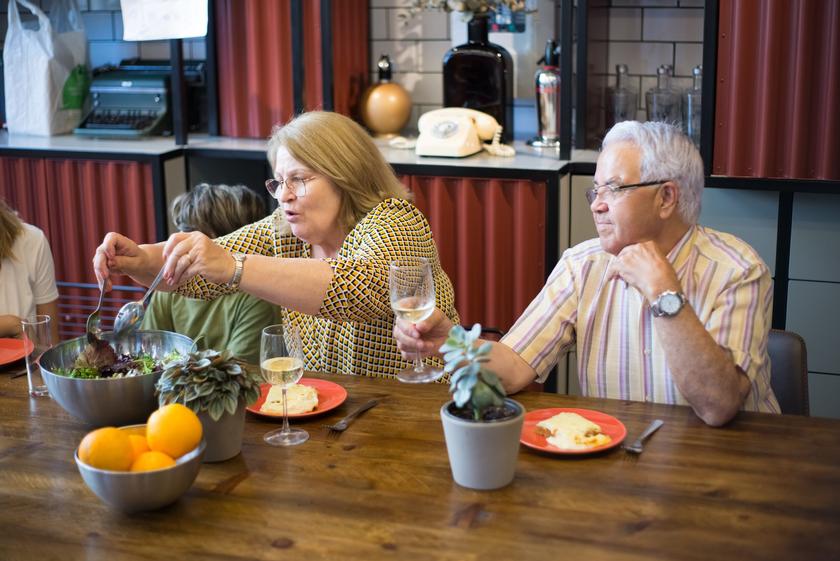Dietary Diversity For Senior Health In Assisted Living

The adage “Variety is the spice of life” encapsulates a profound truth: diversity is the very essence that enriches and invigorates our existence. Consider for a moment the myriad facets of our lives where diversity plays a pivotal role, from the music we savor to the fashion choices that express our individuality. Indeed, diversity keeps the tapestry of life interesting, engaging, and profoundly enjoyable. However, nowhere does the significance of diversity become more palpable than when we delve into the realm of Dietary Diversity for Senior Health in Assisted Living.
Picture the dining table, adorned with a vibrant array of colors, textures, and flavors, each dish carefully crafted not only to delight the senses but also to nourish the body. For seniors, this culinary diversity is not merely a visual feast; it is a cornerstone of their well-being, especially as they navigate the challenges of aging in senior living.
In the pages ahead, we embark on a journey into the world of assisted living communities, where menus are undergoing transformative changes to enhance senior health through the power of dietary diversity. Through innovative strategies and a commitment to culinary excellence, these communities are ensuring that residents not only receive the nutrition they need but also relish the pleasure of delicious, thoughtfully prepared meals every day.
So, fasten your seatbelts because, as you continue reading, you’re not just exploring the nuances of senior care; you’re unraveling the secrets of enhancing the quality of life for our beloved seniors—one delectable plate at a time! Dietary Diversity for Senior Health in Assisted Living is a crucial aspect of this journey.
TABLE OF CONTENTS:
- Understanding the Importance of Dietary Diversity for Senior Health in Assisted Living
- The Role of Registered Dietitians in Assisted Living Facilities
- Strategies for Achieving Dietary Diversity in Assisted Living Facilities
- Challenges in Implementing an Assisted Living Dietary Program
- How Assisted Living Menu Software is Revolutionizing Senior Care
- The Importance of Family Involvement in Monitoring Nutrition Status
- The Benefits of Following a Plant-Based Diet in Assisted Living Facilities
- FAQs in Relation to Dietary Diversity for Senior Health in Assisted Living
- What are the dietary considerations for the elderly?
- Which is a nutritional challenge for elderly residents?
- Why is it important to serve attractive meals to the elderly living in a variety of settings?
- What food groups need to be increased in senior years to help ensure they are receiving adequate nutrients?
- Conclusion
UNDERSTANDING THE IMPORTANCE OF DIETARY DIVERSITY FOR SENIOR HEALTH IN ASSISTED LIVING
It’s like having a colorful palette while painting. The more colors you have, the richer and more vibrant your artwork becomes. That’s how dietary diversity works when it comes to senior health in assisted living communities. It doesn’t just make meals interesting but contributes significantly towards overall well-being.
A diverse diet, think rainbow-colored veggies and fruits on a plate, is crucial as we age because our bodies need different nutrients to function optimally. But don’t mistake this for piling up servings of lasagna or apple pie. We’re talking about variety across all food groups – grains, proteins, dairy products, and yes – sweets too (in moderation).
In an assisted living setting, achieving such balance can be challenging due to various factors contributing to diverse menus which include individual taste preferences, nutritional needs, and special diets required by seniors.
THE ROLE OF DIETARY DIVERSITY IN SENIOR CARE
Diversity isn’t merely for palate pleasure; it plays a significant role in keeping seniors healthy by providing them with essential vitamins and minerals their bodies need every day. Plus point? A delicious meal always lifts spirits.
An underappreciated fact is that taste buds dull over time making older adults enjoy flavors less than they used to leading them sometimes down the path of malnutrition without even realizing it.
IMPACT OF DIETARY DIVERSITY ON OLDER ADULTS’ HEALTH
Eating diverse foods keeps things exciting but also helps avoid ‘nutritional boredom’, resulting from eating similar types of foods regularly causing nutrient deficiencies and eventually affecting overall health.
For example, having too much red meat might give you a good dose of protein but at the same time can increase cholesterol levels. On the other hand, including different sources like chicken, fish, or plant-based proteins not only helps maintain nutritional balance but also keeps cholesterol in check.
FACTORS CONTRIBUTING TO DIVERSE MENUS IN ASSISTED LIVING FACILITIES
Creating diverse menus for seniors involves juggling a lot of balls. We need to consider their specific dietary needs, like managing diabetes or heart disease. But we also can’t forget about personal tastes – maybe someone’s got a soft spot for
Key Takeaway:
Think of a diverse diet as a colorful palette, adding vibrancy to senior health in assisted living. Variety across all food groups ensures optimal nutrient intake and fights ‘nutritional boredom’ while catering to personal tastes and dietary needs adds another layer of complexity. The bottom line? A well-rounded menu is key for senior well-being.
THE ROLE OF REGISTERED DIETITIANS IN ASSISTED LIVING FACILITIES
Think of registered dietitians as the guardians of health and nutrition for seniors living in assisted living facilities. They’re not just experts who understand what makes a balanced meal, but also lifesavers who can spot early signs of malnutrition or other dietary concerns.
A key part of their role is conducting nutritional assessments upon patient admission. This isn’t some cursory glance at a resident’s favorite foods, it’s an extensive process that looks into medical history, lifestyle habits, and unique dietary needs. These initial assessments lay the groundwork for individualized care plans tailored to each senior’s specific needs.
Long Term Care RD, an online resource dedicated to promoting best practices in this field confirms that such personalized attention from registered dietitians is crucial when dealing with complex health issues common among seniors.
But the job doesn’t stop there. To maintain optimal health status for residents over time, regular nutritional reviews are conducted quarterly. These check-ups serve as both preventive measures against potential complications and proactive steps toward improved well-being. Just imagine them like routine car servicing – except they deal with human lives.
MAINTAINING DIETARY BALANCE: A BALANCING ACT INDEED.
Navigating through varied food preferences while ensuring essential nutrient intake requires skill akin to tightrope walking. From creating diabetic-friendly meals packed with taste without extra sugar; accommodating gluten-free requests; incorporating heart-healthy options; or even planning out delicious pureed meals for those having difficulty swallowing – all fall under their purview.
PROMOTING POSITIVE FOOD EXPERIENCES
Beyond basic nutrition management lies another important aspect – enhancing overall dining experiences which greatly impact the quality of life within these communities. A nutritious meal is only as good as its ability to be consumed and enjoyed.
Whether designing attractive food presentations or arranging special meals for festive occasions, registered dietitians play a crucial role in fostering positive experiences around food. This isn’t just about feeding bodies – but nourishing souls too.
Key Takeaway:
Registered dietitians are health heroes in assisted living facilities. They don’t just create balanced meals, they spot dietary issues early and craft individualized care plans for each senior. This involves regular check-ups, navigating diverse food preferences while maintaining essential nutrients, and enhancing dining experiences to nourish both bodies and souls.
STRATEGIES FOR ACHIEVING DIETARY DIVERSITY IN ASSISTED LIVING FACILITIES
The importance of dietary diversity for senior health cannot be underestimated. The key lies in creating a diverse menu with a variety of food groups, while also accommodating special dietary needs and restrictions.
THE ROLE OF PERSONALIZED MEAL PLANS
To cater to individual tastes and preferences, assisted living facilities like Unlimited Care Cottages often use personalized meal plans. This approach lets us meet each resident’s nutritional requirements without sacrificing flavor or quality.
We offer an array of common dietary programs including low-sodium food programs, diabetic-friendly options, vegan diets, and textured meal programs suitable for those who need help swallowing their meals. These initiatives not only ensure that we’re addressing specific health concerns but also make sure our residents enjoy their dining experience.
INCORPORATING CULTURALLY DIVERSE OPTIONS
Cultural diversity is another important factor when planning menus at our cottages. Our kitchen team works hard to include dishes from around the world – think Thai curry one day followed by Italian pasta the next. It’s like having your own personal chef preparing international cuisine just for you.
ASSESSING FEEDING ASSISTANCE NEEDS
The level of feeding assistance a resident needs directly impacts both care levels and cost. Some residents may require minimal aid such as cutting up large pieces into bite-sized morsels while others might need more extensive support during mealtimes.
This understanding allows us to adjust staff resources accordingly so that every resident gets adequate attention during mealtimes, which ultimately contributes towards enhancing their overall well-being at our facility.
CHALLENGES IN IMPLEMENTING AN ASSISTED LIVING DIETARY PROGRAM
The journey to maintain diverse menus in senior care facil

















